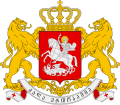Prior to 13th century
| Part of a series on the |
| History of Georgia |
|---|
 |
- 4th C. CE – Narikala Fortress built.
- c. 517 – First Sasanian officials with the title marzban ("margrave") take up residence in Tbilisi. [1]
- 534 CE – Anchiskhati Basilica built (approximate date).
- 6th C. – Capital of Caucasian Iberia moves to Tbilisi from Mtskheta. [2]
- 570 – Persians in power. [3]
- 626 – Town besieged by Greeks. [3]
- 627 – Town sacked by Byzantine/Khazar forces. [4]
- 639 – Sioni Cathedral built (approximate date).
- 653 – Occupation by Arab leader Khabib Ibn-Maslama.
- 736 – Arab Emirate of Tbilisi is established.
- 764 – Town sacked by Khazars.
- 828 – Town besieged by Khazars. [3]
- 851 – Town besieged by Arabs. [3]
- 853 – Town besieged by forces of Arab Bugha Al-Turki.
- 1029 - Svetitskhoveli Cathedral rebuilt.
- 1068 – Town sacked by forces of Seljuk Turk Alp Arslan.
- 1122 – David IV of Georgia comes to power; relocates capital to Tbilisi from Kutaisi.





